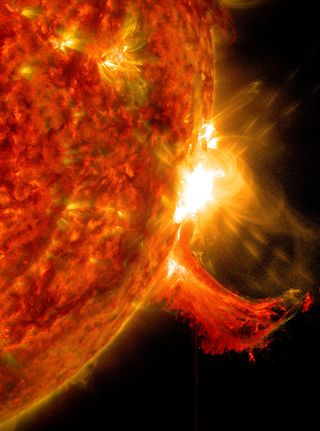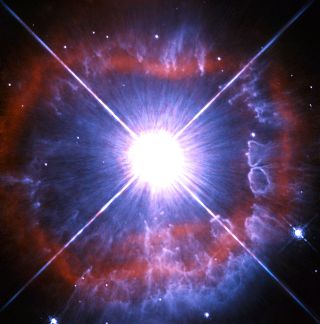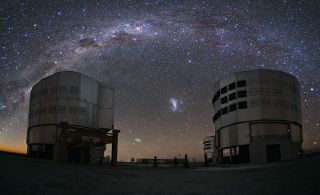Best Space Photos of the Week - Oct. 4, 2014
This week we saw some amazing photos of from space. From dazzling night sky views to India's spectacular view of Mars, it was a week to behold in space. See our favorite space photos of the last week in this gallery, starting with the Red Planet.

On Sept. 28, India's first Mars probe, the Mangalyaan orbiter, snapped its best view yet of the Red Planet. The spacecraft captured a full-globe view of Mars from 46,292 miles (74,500 kilometers) away as it orbited the planet. Mangalyaan (the name is Sanskrit for "Mars Craft") took the photo with its Mars Color Camera, with the Indian Space Research Organisation revealing the photo on Sept. 29 via Twitter and Facebook.
Spectacular Solar Flare Photo from NASA

Last week, the sun erupted with a powerful solar flare that, while beautiful to behold, was not aimed at Earth. The solar flare erupted on Thursday, Oct. 2, and ranked as a class M7.3 solar storm. Class-M flares are moderate solar eruptions that can supercharge Earth's northern lights displays when aimed at our planet.
NASA's Solar Dynamics Observatory captured this amazing image, as well as a stunning video of the M7.3 solar flare.
Amazing Comet Jets

The comet target of the European-built Rosetta spacecraft is not one to disappoint. In this photo, the icy Comet 67P/Churyumov-Gerasimenko is spouting off jets of gas and dust, all of which is being captured in amazing new photos from Rosetta. This photo was captured on Sept. 26 and released by the European Space Agency last week.
Rosetta arrived at Comet 67P/C-G, as it's being called, on Aug. 6 after a 10-year trek across the solar system. The spacecraft will spend the next year following the comet to watch as 67P/C-G's activity changes as it approaches the sun. [See more amazing Rosetta comet photos]
Milky Way and Maine's Raven's Nest

This jaw-dropping photo was captured by night sky photographer Adam Woodworth during a visit to the Raven's Nest at the Acadia National Park in Maine.
Get the Space.com Newsletter
Breaking space news, the latest updates on rocket launches, skywatching events and more!
Read the full story of this spectacular photo to see how Woodworth assembled eight exposures to capture this stunning view.
'Wild Duck' Star Cluster in Flight

The European Southern Observatory wowed us this week with this dazzling view of the "Wild Duck" star cluster as seen by one of its telescopes in Chile's high Atacama Desert. ESO astronomers used the La Silla Observatory to capture this view of the star cluster Messier 11, which is about 6,000 light-years away in the constellation Scutum (The Shield).
As if this photo isn't enough , you can watch a video tour of Messier 11 set to the song "The Leaves" by the band Super 400.
'Interstellar' in Pictures

This week, we saw the unveiling of the final "Interstellar" trailer, a video that is both epic and thrilling and kept us wanting more for the new film by Christopher Nolan. The film will launch in theaters nationwide on Nov. 7.
To celebrate the trailer, we put together the photos we have so far of "Interstellar" into a gallery for your enjoyment. You can see the "Interstellar" pictures here.
Maine's Magnificent Dark Skies (Gallery)

The dark night skies of Maine, devoid of light pollution, can reveal some of the best stargazing views in the continental United States, and it has been a stunning palate for astrophotographer Mike Taylor.
In this gallery of Maine night sky photos by Taylor, the veteran photographer captures stunning vistas of auroras, starry nights and the always dazzling Milky Way.
A Shining Star

The dazzling AG Carinae, also known as HD 94910, shines in this new image by Hubble Space Telescope which we featured as our Image of the Day on Thursday (Oct. 2). The star lies 20,000 light-years away, a member of the Milky Way, lying in the constellation of Carina in the southern sky.
Scientists classify AG Carinae as a Luminous Blue Variable, a massive evolved star that will one day become a Wolf-Rayet Star that will shine up to several million times as luminous as our sun. Stars like AG Carinae lose mass at an extremely rapid rate, blowing it off in powerful stellar winds of up 4.3 million mph (7 million km/hour).
Milky Way Over Cerro Paranal

In this amazing photo, our Image of the Day for Friday (Oct. 3), the Milky Way glitters over ESO's Paranal Observatory atop Cerro Paranal in Chile's high Atacama Desert. ESO photo ambassador Yuri Beletsky took this photo of two telescopes that form part of Paranal's Very Large Telescope facility.
The Large Magellanic Cloud and Small Magellenic Cloud, dwarf galaxies near our own Milky Way, can be seen between the two telescopes. The dark smudge at upper left, obscuring part of the Milky Way, is the Coalsack Nebula. To see more amazing photos from the observatory, visit: Spectacular Cosmic Visions from ESO's Paranal Observatory.
Follow us @Spacedotcom, Facebook and Google+.
Join our Space Forums to keep talking space on the latest missions, night sky and more! And if you have a news tip, correction or comment, let us know at: community@space.com.

Space.com is the premier source of space exploration, innovation and astronomy news, chronicling (and celebrating) humanity's ongoing expansion across the final frontier. Originally founded in 1999, Space.com is, and always has been, the passion of writers and editors who are space fans and also trained journalists. Our current news team consists of Editor-in-Chief Tariq Malik; Editor Hanneke Weitering, Senior Space Writer Mike Wall; Senior Writer Meghan Bartels; Senior Writer Chelsea Gohd, Senior Writer Tereza Pultarova and Staff Writer Alexander Cox, focusing on e-commerce. Senior Producer Steve Spaleta oversees our space videos, with Diana Whitcroft as our Social Media Editor.
